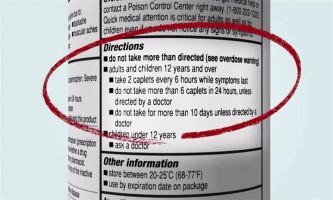Between headaches, stuffy noses, cough and the occasional fever, chances are you’ll at some point reach for over-the-counter medicines (OTC) to combat cold and flu symptoms. OTCs are a safe and effective way to relieve minor ailments when taken as directed, but a new survey suggests Americans are overlooking the Drug Facts label on OTCs.
Two in five Americans see OTC dosing instructions as suggestions, not directions, according to a national survey conducted by Johnson & Johnson Consumer Inc. Also, while 84 percent believe it’s “very important” to read the directions the first time they take prescription medicine, only 72 percent felt that way about OTCs.
Medical experts say that ignoring the label can lead to unnecessary risks like double-dosing, or taking too much of the same active ingredient at the same time. This is especially important during cold and flu season, when it’s not uncommon to take multiple or multi-symptom OTC medicines.
Dr. Darria Long Gillespie, an emergency department physician who partnered with McNeil to encourage the safe use of OTC medicines, says it’s important to read the medicine label each time you take an OTC. “I’ve seen my patients take too high of a dose, too frequently, in combination with medications that could interact, or a medicine that’s not right for their health condition,” she says. “These are unnecessary risks that could easily be prevented by paying close attention to the label.”
Dr. Long Gillespie encourages her patients to know three important things before taking their next OTC medicine.
1. Always read and follow the label — whether it’s the first time or the 100th time. One in four Americans don’t think it’s important to look at labels of OTCs they’ve taken before, according to the survey. But medicine labels and formulations change, and so does our health.
“Even if you use the same pain reliever every month, make it a point to read the label again,” says Dr. Long Gillespie. “Double check dosing instructions, if there are new warnings or directions, and consider any new health conditions or medications you have.”
2. Be aware of active ingredients. Combination medications such as for cold and flu, migraines, and arthritis have multiple active ingredients, which can be very convenient as relief could come in a single pill.
“Many of these different combination medicines have the same active ingredients and taking multiple medications with the same active ingredient can increase your risk of taking too much,” notes Dr. Long Gillespie. She recommends reviewing the active ingredients list, and to only take one medicine with the same active ingredient at a time — whether prescription or OTC.
3. Know your dose, and do not take OTC medicines longer than indicated. According to Dr. Long Gillespie, a common misconception she hears from her patients is that taking more than the recommended doses will improve your symptoms faster or better. “Not only will this not help your symptoms, but it could be harmful. Follow the dosage amounts and be sure to stay under the 24-hour maximum,” she advises.
She also recommends speaking to your doctor or health care provider if you find you need the OTC medicine for more days than recommended. They will be able to help you assess which medicine may be best to treat your symptoms and figure out the cause of your symptoms. “OTCs are not meant for prolonged use,” she says, so never take the OTC for longer than indicated on the label.
As final advice, Dr. Long Gillespie reminds patients to always treat OTC medicines with the same responsibility you would any prescription medication. “The best way to both relieve your symptoms and stay out of harm’s way is by following the instructions on every label, every time,” she says.
(BPT) – Every Label Every Time is a national education initiative from Johnson & Johnson Consumer Inc., McNeil Consumer Healthcare Division to encourage safe and informed use of OTC medicines. For more information, visit www.EveryLabelEveryTime.com.

